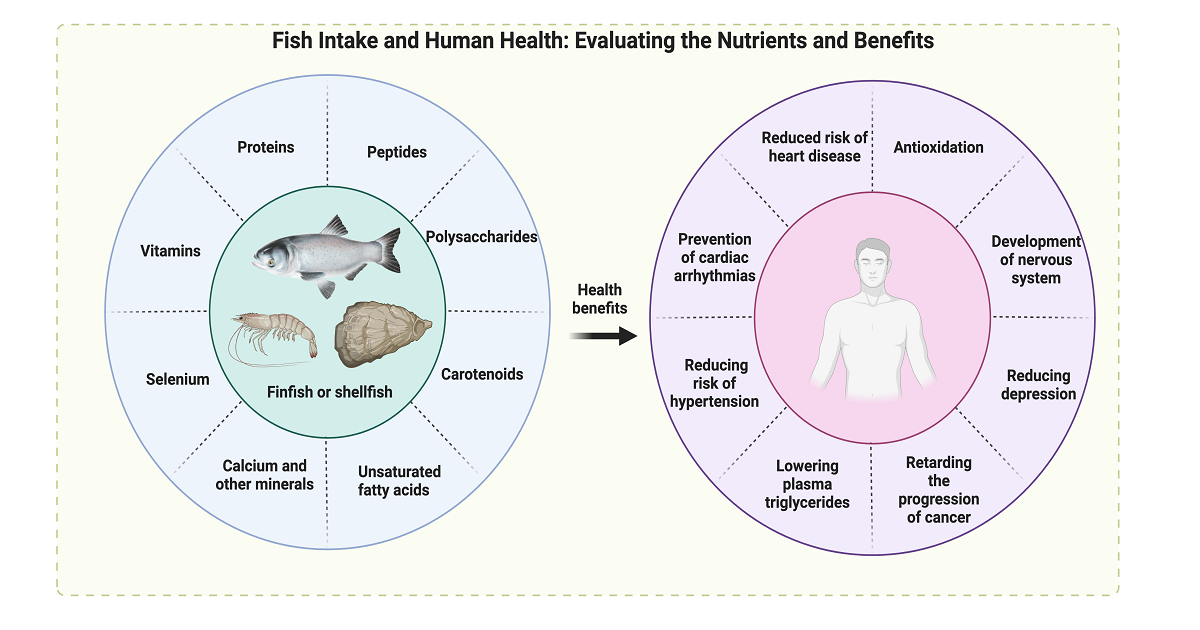- 5.0Impact Factor
- 9.1CiteScore
- 13 daysTime to First Decision
Fish Intake and Human Health: Evaluating the Nutrients and Benefits
This special issue belongs to the section “Nutrition and Public Health“.
Special Issue Information
Dear Colleagues,
Fish (finfish or shellfish) are essential to a healthy diet. Fish are the primary sources of healthy long-chain omega-3 fats and are rich in other nutrients such as vitamin D and selenium, high in protein, and low in saturated fat. There is strong evidence that eating fish or taking fish oil has a positive impact on the heart and blood vessels.
This Special Issue of Nutrients seeks to include manuscripts that provide new insights into the recent advances in the discovery and development of the beneficial compounds (proteins, lipids, peptides, etc.) derived from fish. In addition, their biological effects on cell or animal models will be addressed. Systematic surveys and meta-analyses of fish intake and human health will also be included.
We encourage scientists working in this field of research to submit original research articles or critical reviews that synthesize the current research literature and discuss emerging directions. Thus, these studies will promote the sustainable development of fish aquaculture and the processing industry.
Prof. Dr. Yongkang Luo
Dr. Hui Hong
Dr. Yuqing Tan
Guest Editors
Manuscript Submission Information
Manuscripts should be submitted online at www.mdpi.com by registering and logging in to this website. Once you are registered, click here to go to the submission form. Manuscripts can be submitted until the deadline. All submissions that pass pre-check are peer-reviewed. Accepted papers will be published continuously in the journal (as soon as accepted) and will be listed together on the special issue website. Research articles, review articles as well as short communications are invited. For planned papers, a title and short abstract (about 250 words) can be sent to the Editorial Office for assessment.
Submitted manuscripts should not have been published previously, nor be under consideration for publication elsewhere (except conference proceedings papers). All manuscripts are thoroughly refereed through a single-blind peer-review process. A guide for authors and other relevant information for submission of manuscripts is available on the Instructions for Authors page. Nutrients is an international peer-reviewed open access semimonthly journal published by MDPI.
Please visit the Instructions for Authors page before submitting a manuscript. The Article Processing Charge (APC) for publication in this open access journal is 2900 CHF (Swiss Francs). Submitted papers should be well formatted and use good English. Authors may use MDPI's English editing service prior to publication or during author revisions.
Keywords
- bioactive peptides
- DHA/EPA/PUFA
- cell model
- animal model
- fish

Benefits of Publishing in a Special Issue
- Ease of navigation: Grouping papers by topic helps scholars navigate broad scope journals more efficiently.
- Greater discoverability: Special Issues support the reach and impact of scientific research. Articles in Special Issues are more discoverable and cited more frequently.
- Expansion of research network: Special Issues facilitate connections among authors, fostering scientific collaborations.
- External promotion: Articles in Special Issues are often promoted through the journal's social media, increasing their visibility.
- e-Book format: Special Issues with more than 10 articles can be published as dedicated e-books, ensuring wide and rapid dissemination.

